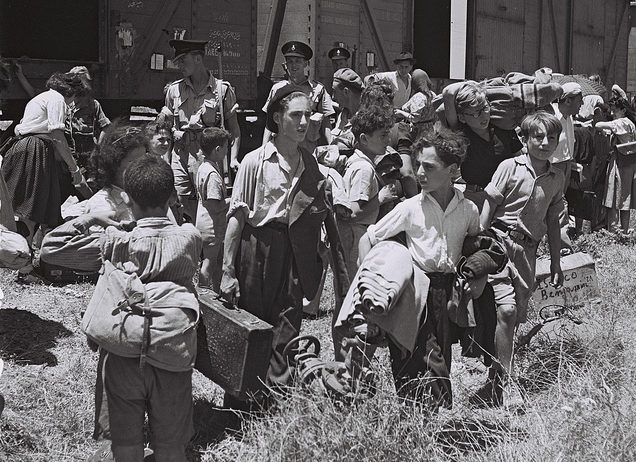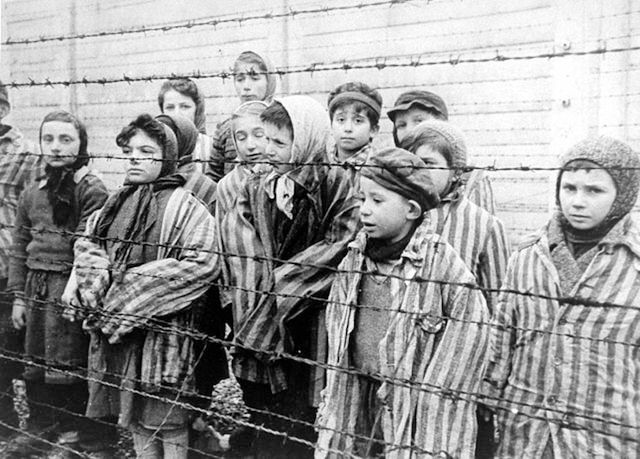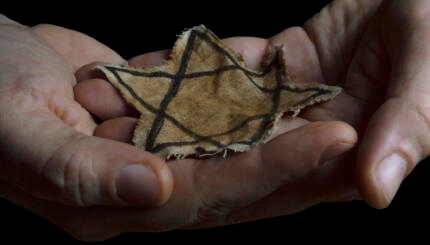Children were especially vulnerable in the era of the Holocaust.
The Nazis advocated killing children of “unwanted” or “dangerous” groups either as part of the “racial struggle” or as a measure of preventative security. The Germans and their collaborators killed children for these ideological reasons and in retaliation for real or alleged partisan attacks.
The Germans and their collaborators killed as many as 1.5 million children. This number included over a million Jewish children and tens of thousands of Romani (Gypsy) children, German children with physical and mental disabilities living in institutions Polish children, and children residing in the occupied Soviet Union. Some Jewish and some non-Jewish adolescents (13-18 years old) had a greater chance of survival, as they could be used for forced labor.
The fates of Jewish and non-Jewish children can be categorized in the following ways:
With your help, My Jewish Learning can provide endless opportunities for learning, connection and discovery.
1) children killed when they arrived in killing centers
2) children killed immediately after birth or in institutions
3) children born in ghettos and camps who survived because prisoners hid them
4) children, usually over age 12, who were used as laborers and as subjects of medical experiments
5) children killed during reprisal operations or so-called anti-partisan operations.

In the Ghettos
In the ghettos, Jewish children died from starvation, exposure, and a lack of adequate clothing and shelter. The German authorities were indifferent to this mass death. They considered most of the younger ghetto children to be unproductive and hence “useless eaters.” Because children were generally too young to be used for forced labor, German authorities generally selected them, the elderly, ill, and disabled, for the first deportations to killing centers, or as the first victims led to mass graves to be shot.
In the Killing Centers
Camp authorities sent the majority of children directly to the gas chambers upon arrival at Auschwitz-Birkenau and other killing centers. SS and police forces in German-occupied Poland and the occupied Soviet Union shot thousands of children at the edge of mass graves.
Sometimes the selection of children to fill the first transports to the killing centers or to provide the first victims of shooting operations resulted from the agonizing and controversial decisions of Jewish council (Judenrat) chairmen. The decision by the Judenrat in Lodz in September 1942 to deport children to the Chelmno killing center was an example of the tragic choices made by adults when faced with German demands. Janusz Korczak, director of an orphanage in the Warsaw ghetto, however, refused to abandon the children under his care when they were selected for deportation. He accompanied them on the transport to the Treblinka killing center and into the gas chambers, sharing their fate.

Non-Jewish Children
Non-Jewish children from certain targeted groups were not spared. Examples include Romani (Gypsy) children killed in Auschwitz; 5,000 to 7,000 children killed as victims of the “euthanasia” program; children murdered in reprisals, including most of the children of Lidice; and children in villages in the occupied Soviet Union who were killed with their parents.
In Concentration and Transit Camps
The German authorities also incarcerated a number of children in concentration camps and transit camps. SS physicians and medical researchers used a number of children, including twins, in concentration camps for medical experiments that often resulted in the deaths of the children. Concentration camp authorities deployed adolescents, particularly Jewish adolescents, at forced labor in the concentration camps, where many died because of conditions.
The German authorities held other children under appalling conditions in transit camps, including Anne Frank and her sister in Bergen-Belsen, and non-Jewish orphaned children whose parents the German military and police units had killed in so-called anti-partisan operations. Some of these orphans were held temporarily in the Lublin/Majdanek concentration camp and other detention camps.
In Occupied Poland and the Occupied Soviet Union
In their “search to retrieve ‘Aryan blood,'” SS race experts ordered hundreds of children in occupied Poland and the occupied Soviet Union to be kidnapped and transferred to the Reich. The children were to be adopted by racially suitable German families. Although the basis for these decisions was “race-scientific,” often blond hair, blue eyes, or fair skin was sufficient to merit the “opportunity” to be “Germanized.”
“Race experts” also determined whether a child would have sufficient German blood. This occurred in situations where female Poles and Soviet civilians who had been deported to Germany for forced labor became pregnant after sexual relations (often under duress) with a German man. If the “race experts” determined that the child would not have enough German blood, the women were forced to have abortions or to bear their children under conditions that would ensure the infant’s death.
Resistance and Rescue
In spite of their acute vulnerability, many children discovered ways to survive. Children smuggled food and medicines into the ghettos, after smuggling personal possessions to trade for them out of the ghettos. Children in youth movements later participated in underground resistance activities. Many children escaped with parents or other relatives—and sometimes on their own—to family camps run by Jewish partisans.
Kindertransport (Children’s Transport) was the informal name of a rescue effort between 1938 and 1940 which brought thousands of refugee Jewish children (without their parents) to safety in Great Britain from Nazi Germany and German-occupied territories.
Some non-Jews hid Jewish children and sometimes, as in the case of Anne Frank, hid other family members as well. In France, almost the entire Protestant population of Le Chambon-sur-Lignon, as well as many Catholic priests, nuns, and lay Catholics, hid Jewish children in the town from 1942 to 1944. In Italy and Belgium, many children survived in hiding.

After the War
After the surrender of Nazi Germany, ending World War II, refugees and displaced persons searched throughout Europe for missing children. Thousands of orphaned children were in displaced persons camps. Many surviving Jewish children fled eastern Europe as part of the mass exodus (Brihah) to the western zones of occupied Germany, en route to the Yishuv (the Jewish settlement in Palestine). Through Youth Aliyah (Youth Immigration), thousands migrated to the Yishuv, and then to the state of Israel after its establishment in 1948.
Reprinted with permission from the United States Holocaust Memorial Museum’s Holocaust Encyclopedia.



